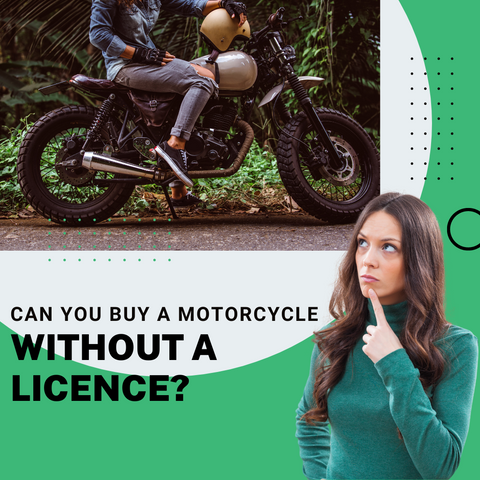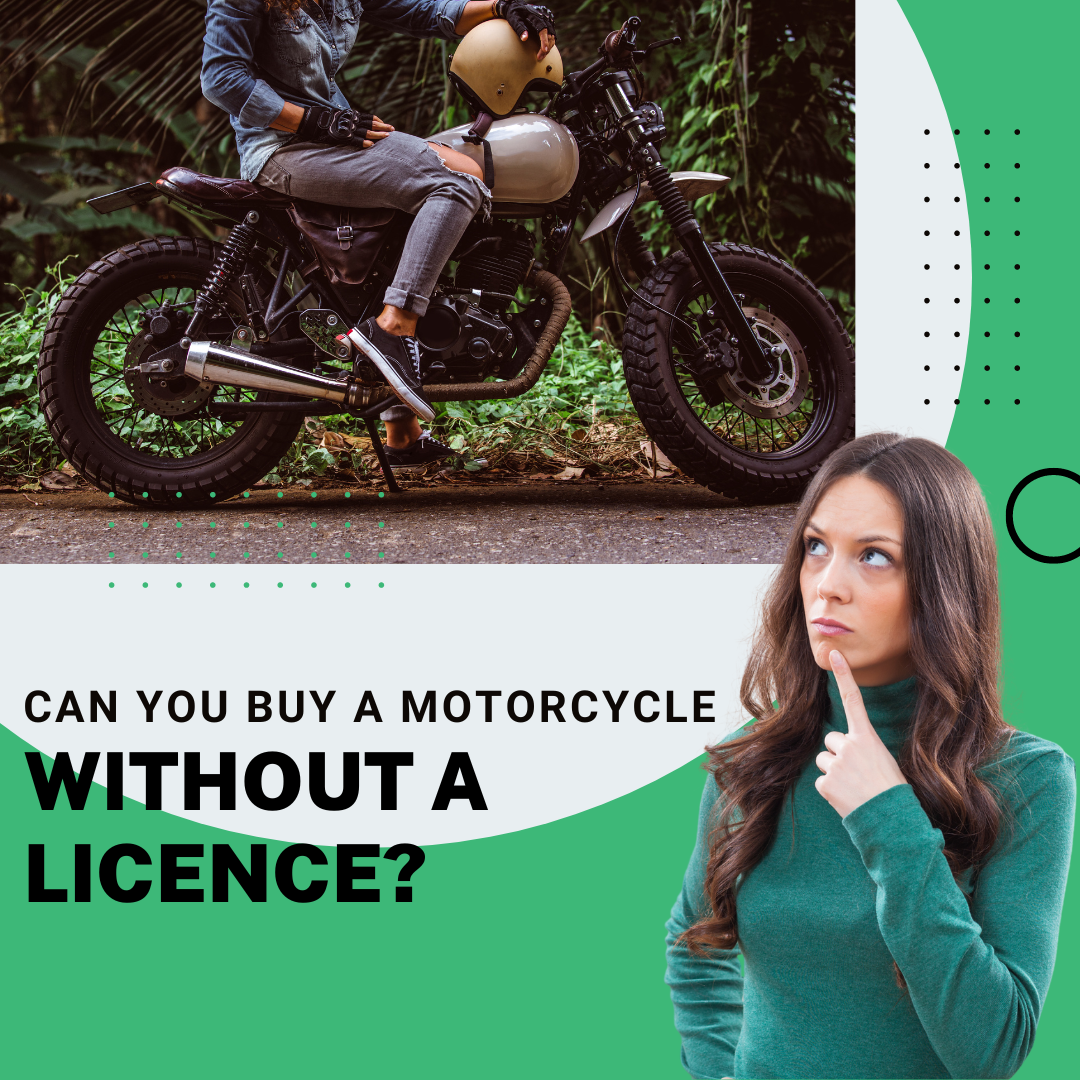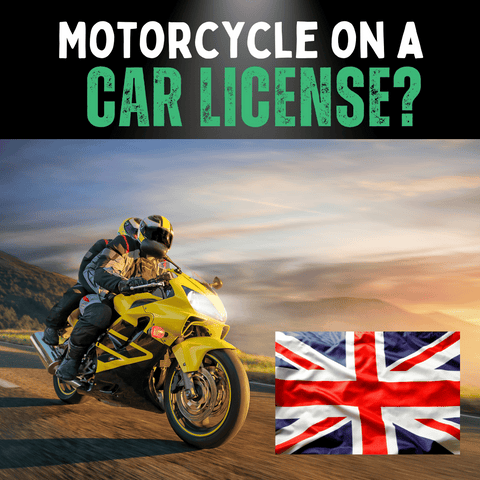Published: 3.7.23
Updated: 13.3.25
Have you ever thought about the thrill of riding a motorcycle, the wind in your hair, the freedom of the open road?
But then comes the question – can you ride a motorcycle without a license? 
Here's the short answer to "Can You Ride A Motorcycle Without A License?"
In the UK, riding a motorcycle without a license is illegal. To legally ride, you must first obtain a provisional license and then complete the Compulsory Basic Training (CBT). Once you pass your CBT, you need to pass a theory test and a practical test. The theory and practical tests must be passed within two years of each other. Depending on your age and experience, you may qualify for different levels of licenses, each requiring successful completion of specific tests. Riding without a license carries penalties, including hefty fines and possible motorcycle impoundment.
The Necessity of a Motorcycle License
The straightforward answer is, no, it's illegal to ride a motorcycle without a valid license in the UK.
To experience the joy of motorcycling legally, you must possess a valid CBT certificate and pass the motorcycle theory and practical tests.
Understanding the UK Motorbike Licensing System
In the UK, there are different types of motorcycle licenses depending on the age and experience of the rider (1234).
To ride a motorcycle legally in the UK, you must have a valid CBT certificate and pass the motorcycle theory and practical tests to get the entitlement (12).
There are two routes to access motorcycles - progressive or direct.
The different types of licenses are:
- AM license: allows riders aged 16 and over to ride a 50cc bike with a maximum speed of 28mph (24).
- A1 license: allows riders aged 17 or over to ride a 125cc bike with L plates, but you can't carry a passenger or ride on motorways (24).
- A2 license: allows riders aged 19 and over to ride any bike with a power-to-weight ratio not exceeding 0.2kw/kg (any restriction in power cannot be derived from a vehicle of more than double its power) (234).
- A license: allows riders aged 21 and over to ride any bike of any sized engine if they have held an A2 license for two years or more (4).
It is illegal to ride a motorcycle on a public road without a valid license in the UK (56).
Riding without a license can result in a penalty of three to six points on your license, a fine, and even imprisonment in extreme cases (6).
In the UK, there are different types of motorcycle licenses depending on the age and experience of the rider (1234).
To ride a motorcycle legally in the UK, you must have a valid CBT certificate and pass the motorcycle theory and practical tests to get the entitlement (12).
There are two routes to access motorcycles - progressive or direct.
The different types of licenses are:
- AM license: allows riders aged 16 and over to ride a 50cc bike with a maximum speed of 28mph (24).
- A1 license: allows riders aged 17 or over to ride a 125cc bike with L plates, but you can't carry a passenger or ride on motorways (24).
- A2 license: allows riders aged 19 and over to ride any bike with a power-to-weight ratio not exceeding 0.2kw/kg (any restriction in power cannot be derived from a vehicle of more than double its power) (234).
- A license: allows riders aged 21 and over to ride any bike of any sized engine if they have held an A2 license for two years or more (4).
It is illegal to ride a motorcycle on a public road without a valid license in the UK (56).
Riding without a license can result in a penalty of three to six points on your license, a fine, and even imprisonment in extreme cases (6).
Legal Exceptions and Temporary Permits
While a full motorcycle license is generally required to ride on public roads, there are some exceptions and temporary permits available:
-
Compulsory Basic Training (CBT): After completing a CBT course, you can ride a motorcycle up to 125cc with L plates for two years without taking a full test.
-
Provisional License: With a provisional license and completed CBT, you can ride a moped (up to 50cc) from age 16, or a motorcycle up to 125cc from age 17, with L plates.
-
Full Car License: If you passed your car test before 1 February 2001, you can ride a moped (up to 50cc) without L plates and without taking CBT.
-
Off-road Riding: No license is required to ride a motorcycle on private land, with the landowner's permission.
-
Motorcycle Trade License Plates: These allow mechanics and dealers to ride motorcycles for testing and delivery purposes without registering each bike individually.
-
International Driving Permits: Visitors to the UK can ride motorcycles for up to 12 months on their foreign license, provided it's valid for motorcycles in their home country.
Remember, even with these exceptions, it's crucial to prioritise safety and follow all relevant traffic laws and regulations.
Always wear appropriate safety gear and consider taking additional training courses to improve your riding skills.
Related: What Motorbike Can I Ride On A Car Licence?
The Compulsory Basic Training (CBT)
The first step to getting your motorcycle license is Compulsory Basic Training (CBT).
This motorcycle test ensures that you are competent and safe to ride on the roads.
Progressive and Direct Access Routes
There are two pathways for you to follow: the progressive route and the direct access route.
These paths provide different steps to gain your bike license, whether you're a novice non-rider or older seeking an age-based license.
Related: LEGAL AGE for 50cc Dirt Bikes
Consequences of Riding Without a License
Riding a motorcycle without the appropriate license carries heavy penalties.
You could receive a hefty fine, and your motorcycle could be impounded at your expense.
In severe cases, depending on why you don’t have a license, you could even face jail time.
Process of Getting a Motorcycle License
Theory Test and Practical Test
After completing the CBT, the next steps are the motorcycle theory exam and the practical test.
The theory exam tests your knowledge, while the riding assessment measures your on-road skills.
It's advisable to thoroughly study the Highway Code, practice sample test questions, and use learning resources like books and apps designed to prepare you for the test.
The practical test is a two-part exam - Module One (off-road test) and Module Two (on-road test).
Module One evaluates your motorcycle handling skills in various situations, while Module Two focuses on your ability to navigate public roads safely.
You should consider taking professional lessons to prepare for these tests.
Remember, practice makes perfect, so spend a good amount of time honing your skills on the road under the supervision of a licensed instructor or another qualified motorcyclist.
Different Types of Licences: AM, A1, A2, and A Licences
Depending on your age and experience, you can pursue different levels of licenses, ranging from an AM licence (moped license) to a full A licence (unrestricted motorcycle license).
Each of these licences requires you to pass the Module One off-road test and the Module Two on-road test, ensuring your complete understanding of motorcycle handling and road riding.
| License Type | Description |
|---|---|
| AM Licence | Allows you to ride two-wheeled vehicles with a maximum design speed of 45 km/h (moped license). |
| A1 Licence | It permits you to ride motorcycles up to 125cc with a power output of up to 11kW (light motorcycle license). |
| A2 Licence | Grants permission to ride motorcycles with a power output of up to 35kW (restricted or intermediate license). |
| A Licence | Allows you to ride any motorcycle with no power or speed restrictions (full or unrestricted motorcycle license). |
Remember, obtaining any of these licenses involves passing the necessary theory and practical tests within the UK's motorcycle licensing system.
If you're interested in learning about Kids Electric Ride-On Motorbikes, I recommend clicking on this link.
Challenges of Buying a Motorcycle Without a License
While buying a new or used motorcycle without a license is legal, it presents a myriad of challenges.
You won't be able to test or drive the motorcycle home once you purchase it. And while motorcycle registration doesn't require a license, it usually necessitates insurance.
However, obtaining an insurance policy to protect your bike against fire, theft, and other accidents can be complicated without a license.
Here's what you need to know about insuring a motorcycle without a license:
Insurance Options
Some insurance companies do offer policies for motorcycles owned by unlicensed individuals. However, these policies typically have limitations:
- You may only be able to get comprehensive coverage, which protects against theft, fire, and damage while parked.
- Liability and collision coverage are usually not available without a license.
- You'll likely need to list a licensed rider as the primary operator on the policy.
Potential Insurers
Not all insurance companies offer coverage for unlicensed owners. Some that may consider it include:
- Progressive
- Dairyland
- Foremost
It's best to contact insurers directly to inquire about their specific policies for unlicensed owners.
Minimising Premiums
Even without a license, there are ways to potentially reduce insurance costs:
- Install anti-theft devices and store the bike in a secure garage.
- Take a motorcycle safety course, even if you're not licensed to ride yet.
- Opt for a higher deductible, but ensure you can afford it if needed.
- Consider temporary or laid-up insurance if you only plan to store the bike.
Legal Considerations
Remember that while you can insure and own a motorcycle without a license, it remains illegal to ride it on public roads.
You'll need to obtain the proper license before operating the vehicle.
By understanding these insurance complexities, you can better navigate the challenges of motorcycle ownership without a license.
However, for the fullest riding experience and coverage options, obtaining a motorcycle license is highly recommended.
For information on how to change the oil and oil filter on your motorbike or quad bike, this link will provide all the details you need.
Tips for Passing Your Motorcycle Theory and Practical Tests
Obtaining your motorcycle license is a crucial step towards legally riding your motorcycle.
Here are some practical tips to help you ace both the theory and practical tests:
Theory Test Preparation
-
Study the handbook: Thoroughly review your state's motorcycle operator manual, which covers all the essential rules and regulations.
-
Use practice tests: Take advantage of online practice tests to familiarize yourself with the format and types of questions you'll encounter.
-
Focus on key areas: Pay special attention to traffic laws, road signs, and safety procedures specific to motorcycles.
-
Utilize mobile apps: Download motorcycle theory test apps for on-the-go studying and quick quizzes.
Practical Exam Preparation
-
Enroll in a motorcycle safety course: These courses often include practice sessions that mimic the practical test.
-
Master basic maneuvers: Practice slow-speed control, turning, stopping, and emergency braking in a safe, off-road environment.
-
Familiarize yourself with test routes: If possible, learn the common routes used for practical tests in your area.
-
Check your motorcycle: Ensure your bike is in good working condition and meets all legal requirements.
Additional Resources
- Books: "Motorcycle Safety Foundation's Guide to Motorcycling Excellence" and "Total Control: High Performance Street Riding Techniques"
- Websites: Visit your state's Department of Motor Vehicles website for official information and resources
- YouTube channels: Look for channels dedicated to motorcycle safety and riding techniques
Remember, thorough preparation is key to passing both the theory and practical tests.
Take your time to study and practice, and don't hesitate to seek help from experienced riders or professional instructors if needed.
With dedication and the right resources, you'll be well on your way to obtaining your motorcycle license and enjoying the freedom of the open road.
In Summary
While the excitement of owning and riding a motorcycle can be enticing, the legality and consequences of riding without a license make it a risk not worth taking.
The best route is to follow the correct legal procedures, take the necessary tests, and earn the right to enjoy the thrill of motorcycling with the wind in your hair, legally and safely.
Remember, the road is more enjoyable when you’re riding responsibly!
FAQs
What is the penalty for riding a motorcycle without a license in the UK?
If you are caught riding a motorcycle without a valid license in the UK, you may receive a penalty of three to six points on your license, which will be endorsed on your official license once you have acquired the correct one. In addition, you may face a fine of up to £1,000 or even imprisonment in extreme cases. Furthermore, if you cause an accident without a motorcycle license, your insurance coverage may lapse. Therefore, it is important to obtain the appropriate license before riding a motorcycle on public roads in the UK to avoid any legal consequences.
What is the difference between a motorcycle permit and a license in the UK?
In the UK, a motorcycle permit is a temporary legal document allowing an individual to learn to operate a motorcycle under certain conditions, like not being able to carry passengers, ride at night, or on freeways. However, a motorcycle license grants full riding privileges without restrictions. A license, unlike a permit, is necessary for legally operating a motorcycle on public roadways at any time.
Can you insure a motorcycle without a license in the UK?
While it's possible to insure a motorcycle without a license in the UK, it may be challenging. Insurance companies often see unlicensed drivers as a higher risk, potentially leading to difficulty finding a willing insurer. Additionally, your insurance coverage may lapse if you cause an accident without a valid license. Even though you can insure a motorcycle without a license, it is still illegal to ride without one. It's crucial to get the appropriate license before riding on public roads to avoid legal issues.









Share:
Are Motorcycles Automatic Or Manual? (Updated 2025)
How To Start A Quad With A Dead Battery (STEP BY STEP)